Delve into this comprehensive guide brimming with actionable decluttering tips specifically designed to help hoarders reclaim their living spaces and transform their lives.
Battling with hoarding can be a daunting task, but the journey towards a clutter-free life is achievable with the right steps. This article is designed to provide practical decluttering tips specifically tailored for hoarders.
It offers an in-depth guide to help you navigate through the clutter, organize your space, and maintain a tidy environment. From understanding the psychology behind hoarding to implementing effective decluttering strategies, you’ll find comprehensive solutions that address your needs.
So, whether you’re just starting your decluttering journey or you’re stuck somewhere in the middle, these tips will provide the guidance you need to continue moving forward.
Understanding Hoarding Behavior

Typically rooted in emotional experiences and psychological conditions, hoarding is a complex disorder marked by the extreme collection of items paired with difficulty discarding possessions.
Often triggered by loss or trauma, hoarding becomes a protective mechanism for individuals who may attribute excessive emotional attachments to material goods.
Hoarders often believe that these items will be useful or needed in the future or that they hold an intrinsic value, making it difficult for them to part with them.
Understanding the root cause of this behavior is the first step towards treatment and recovery, paving the way towards a clutter-free life.
The Psychology of Hoarding

Psychological factors play a pivotal role in hoarding behaviors. Often, these habits are rooted in deep-seated emotional attachments to possessions, linked to fear of losing important or meaningful items.
Individuals may keep excessive amounts of items, believing they hold significant value or that they might need them in the future.
In certain cases, the inability to decide what to keep or throw away causes distress, leading to clutter that affects their living conditions.
Anxiety or depression can also contribute to hoarding. Unearthing these factors enables the formulation of effective decluttering strategies, simultaneously addressing the emotional challenges tied to these behaviors.
It’s crucial to approach the decluttering process with empathy and understanding, considering the emotional turmoil it might provoke.
Importance of Decluttering for Hoarders
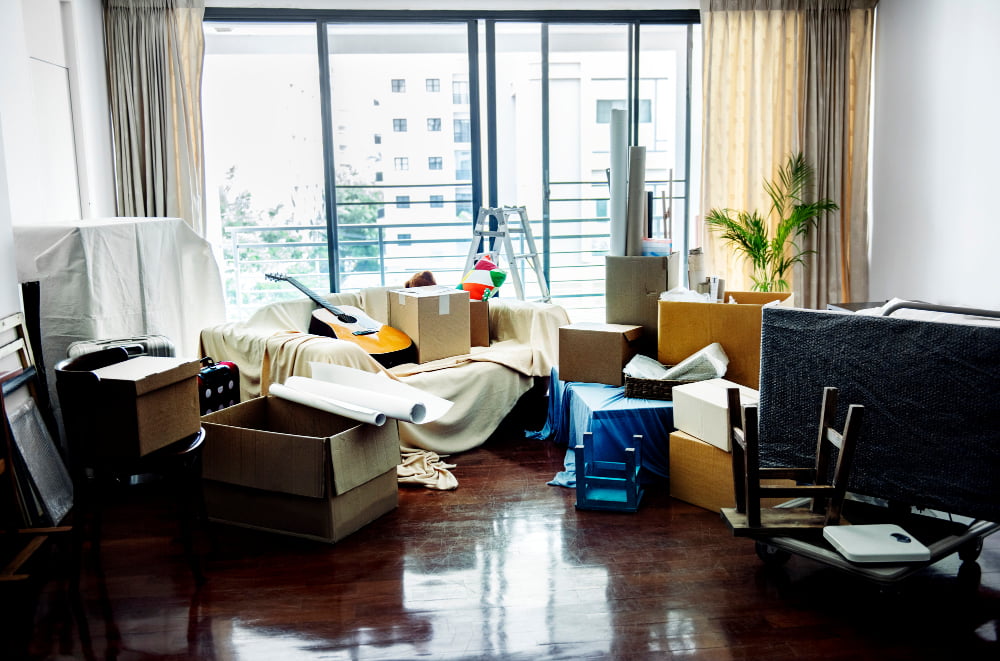
Living in a cluttered environment can lead to increased stress, reduced productivity, and even health hazards.
Overcoming this issue promotes not only physical wellbeing, but mental and emotional health as well.
A tidy, organized space provides a sense of control over one’s environment, generating feelings of accomplishment and peace.
Furthermore, it eliminates the danger of physical injury from tripping hazards or falling objects.
On a practical level, it enables efficient use of space and makes it easier to find items when needed.
Ultimately, decluttering paves the way for hoarders to lead safer, healthier lives, fostering improved relationships with family members who may have been negatively impacted by the clutter.
Identifying Items to Keep and Discard

Start by categorizing items into three groups: essential, non-essential, and discard.
Essentials are items you use daily or weekly such as work supplies, kitchen utensils, personal care items, etc.
Non-essentials are things you use less often but still need or cherish, like seasonal clothing, decor, or hobby equipment.
The discard pile should include items you have not used in over a year, duplicates, or things that are no longer functional.
Remember, your goal is to reduce clutter, so be brutally honest with yourself.
If you are not sure about the item, consider the one-year rule – if you haven’t used it in a year, it is a candidate for the discard pile.
Though challenging, avoid attaching emotional value to items.
Attachment and “just in case” thinking might keep you from decluttering effectively.
One method to help with this is taking photographs of sentimental items before giving them away or recycling them.
By being ruthless in this process, you make room for new experiences and the peace that comes with a clean, orderly environment.
Organizing a Decluttering Schedule

Begin by setting aside dedicated periods for decluttering to ensure there’s ample time to effectively carry out the process. Consider breaking your schedule down into manageable parts, such as spending 15 to 30 minutes per day or dedicating a whole weekend, depending on the scale of clutter.
Develop a routine that fits your lifestyle and pace, consequently minimizing overwhelm. Note dates and specific tasks on a calendar – an excellent visual reminder. Implement a systematic approach, working room-by-room or by item categories.
Be realistic about your energy levels and availability to prevent burnout. Ensure to include breaks to recoup and reflect on your progress. This structured approach will provide clarity amidst the chaos, making the overwhelming task of decluttering more attainable and less stressful.
Remember, consistency is key – even small daily efforts can lead to significant progress over time.
Breaking Down Large Tasks Into Smaller Ones
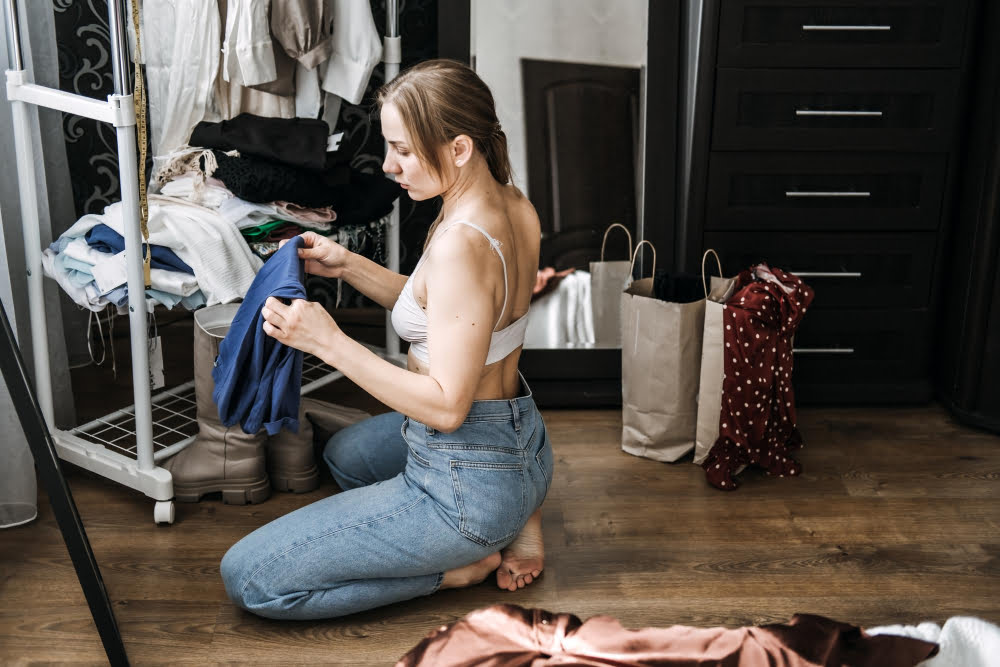
Bite-sizing a mammoth task is a crucial strategy. Start by categorizing items into groups such as clothing, books, utensils, etc.
Instead of attempting to declutter an entire room in a day, allocate specific time periods to sort through each category.
This makes the task more manageable psychologically and physically.
Timely breaks are also essential to avoid overwhelming feelings and maintain consistent progress.
Remember, progress, no matter how slight, is a step in the right direction.
Stick to the task, and gradually, the piles will start to dwindle.
Soon, this method will yield a visible change in your living space, reinforcing your motivation to continue.
Decluttering: One Room At a Time

Start with a room that isn’t overbearing; the bathroom or kitchen can be excellent starting points. Begin by clearing out unnecessary items from the countertops, drawers, and cupboards. Consider asking yourself questions such as “Have I used this in the last year?” or “Does this item bring value to my life?“
Next, move to other rooms and adopt the same decluttering principles. Remove items that no longer serve a purpose. Creating a separate pile for items to keep, donate, and discard can streamline the process. Remember, the goal isn’t to purge everything instantly; it’s about making consistent progress.
Once a room is decluttered, give it a thorough cleaning before reorganizing it. Group similar items together and designate a specific spot for them. Having an organized system will deter clutter from piling up again.
Dealing With “Maybe” Items
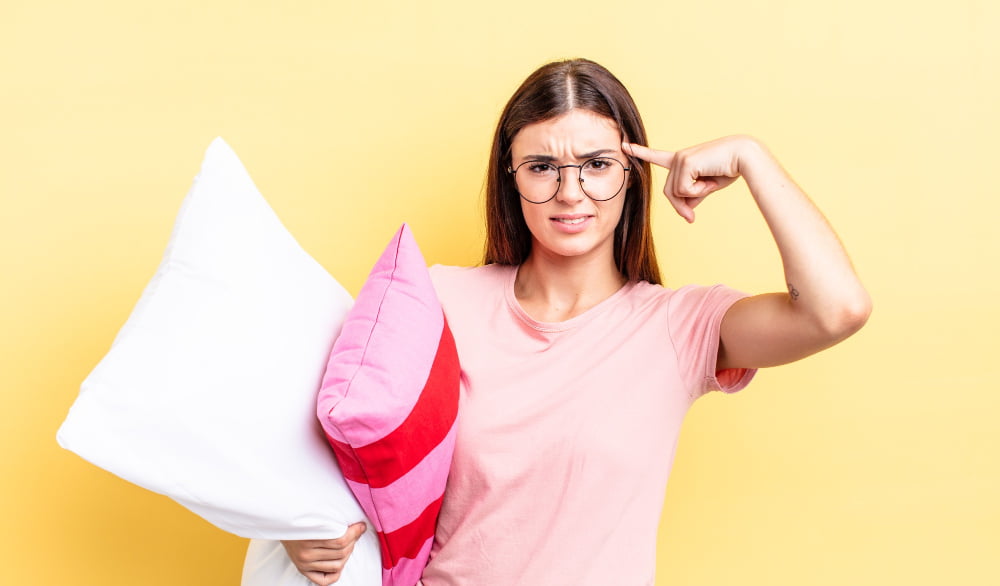
Start by categorizing such items separately. This avoids mixing them with definite ‘keep’ or ‘discard’ items and keeps them from causing disruptions in the decluttering process.
Then, create a timetable, say a 30-day period, during which the usage of these items is observed. That which doesn’t get used within this period should be considered for disposal. Varied thoughts might emerge during this period, but it’s paramount to stick strictly to the rule.
This approach essentially provides a ‘trial period’ that can help make a more informed decision about the item’s value in your life. Remember, the ultimate goal is to achieve a clutter-free living space. Consistency and objective judgment are your best tools.
How to Handle Sentimental Items

Sentimental items often serve as tokens of cherished memories, making decluttering a delicate process.
Begin sorting by creating two categories – those you use and love frequently, and those that simply occupy storage space.
Photograph items before passing them on for keepsake, this alleviates the fear of forgotten memories.
Resist the urge to categorize all items as sentimental.
Remember, not all items from the past have equal emotional value.
If specific belongings evoke happiness or are tied to a significant person or event, it’s reasonable to keep them.
However, for possessions that stir up guilt or obligation, it’s best to consider letting them go.
If deciding proves difficult, consider a temporary store box.
Place items of uncertainty in it and review this box in six months.
Any items you forgot about or did not miss could be discarded.
For pieces with significant emotional value or that belonged to departed loved ones, incorporating or repurposing them in your daily life could be beneficial.
A quilt could become a wall hanging, or jewelry could be transformed into decorative pieces.
Remember to respect the process and pace yourself.
It is absolutely alright to take the time you need to be comfortable with your decisions.
Patience and perseverance are key to handling sentimental clutter.
The Four-box Method for Decluttering

Implement this practical strategy to simplify your decluttering process. Begin by gathering four boxes and labeling them as “Keep”, “Donate”, “Trash”, and “Relocate”.
The “Keep” box is for items that are still useful and have a designated place in your home. The “Donate” box should contain items in good condition that could help others. Fill the “Trash” box with broken, unusable items, or those past their prime. The “Relocate” box contains items which are to be moved to other rooms in your home.
Once you have your four boxes ready, start sorting through items in the designated area – one piece at a time. Place each item in one of the boxes based on its value and usefulness. This method makes decluttering less overwhelming by breaking it down into smaller, manageable tasks and helps make speedy, yet thoughtful decisions.
By the end of this process, you’ll have a clear overview of what to keep, discard, donate, or relocate, streamlining your decluttering journey and making your space more organized.
Digitizing Paper Clutter
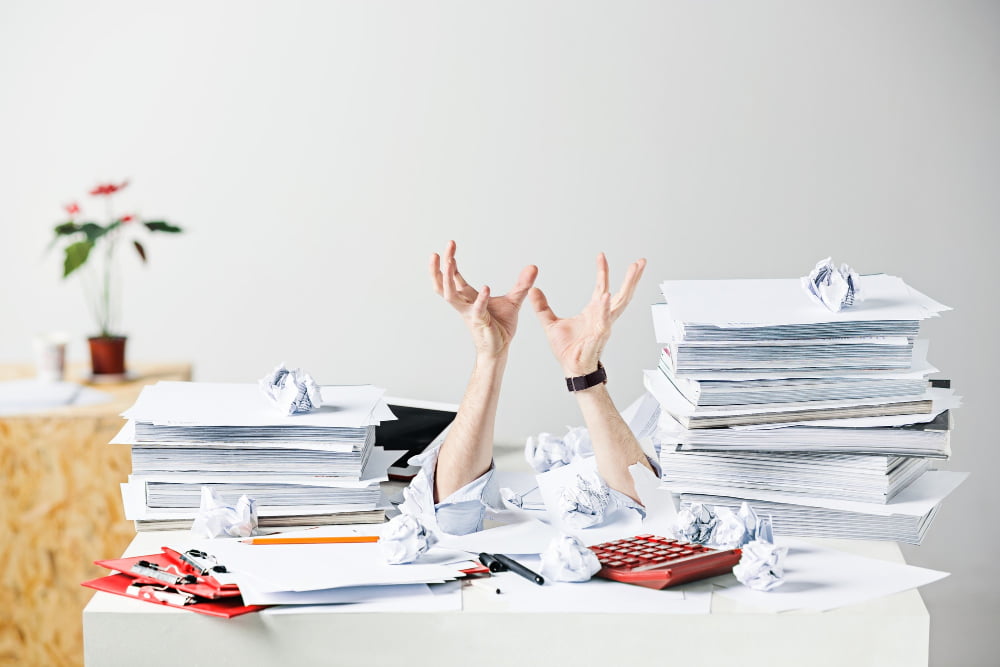
In this digital age, technology can alleviate your battle against paper clutter. The process begins by inventorying your collection, distinguishing between essential documents, hobbies or interest items, and expendable papers.
Essential documents include bills, contracts, or health records, which should be scanned and stored securely in cloud storage or a dedicated hard drive. Remember to make multiple copies for safety. Services like Google Drive offer ample free storage to suit typical needs.
For hobby or interest items like magazine articles, recipes, or personally valuable letters, consider utilizing apps that allow you to capture these documents, even with your phone camera, and digitize them effectively. Many of these apps, like Adobe Scan or CamScanner, include text recognition allowing you to search the contents later.
Once documents are digitally stored and redundantly backed up, you can safely dispose of the physical copies. Shredding is recommended for personal or sensitive documents. For disposition, reach out to local recycling programs. Digitization not only mitigates the physical clutter but also makes document retrieval easier and faster. Adhering to a digitization routine for newly arriving paper prevent potential clutter resurgence.
Decluttering Tips for Special Items (Books, Clothing, Etc.)
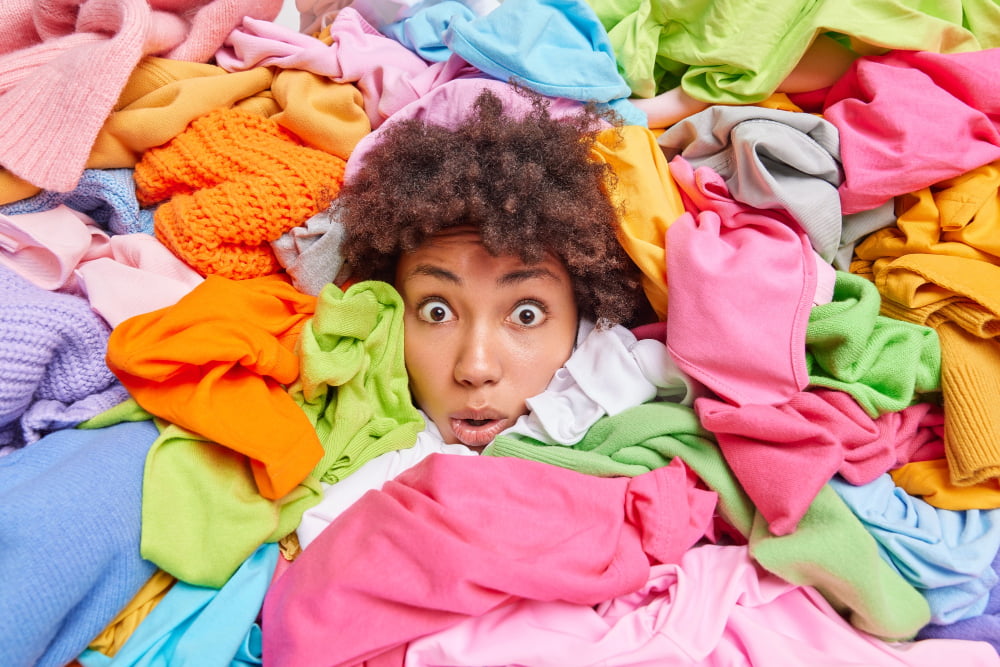
Start by categorizing special items, such as books or prized clothing. For books, consider their importance and frequency of usage. If you haven’t read a book for more than a year, or if it doesn’t hold sentimental value, it’s a candidate for donation or selling.
When it comes to clothing, apply the “one-year-rule”; if it hasn’t been worn for a year, chances are you won’t miss it. Make exceptions for seasonal outfits and clothing with significant sentimental value.
For other categories like CDs, DVDs, or collectibles, apply similar principles. Consider digitizing media to save space while retaining the content. Collectibles can prove challenging due to sentimental attachments. Evaluating the joy an item brings, versus the inconvenience or stress it may cause due to clutter, can help in making effective decisions.
Decluttering special items is not about letting go of cherished memories or personal interests. It’s about making room for new experiences by eliminating excess physical belongings. Approach this process with a focus on balance for a healthier, clutter-free environment.
Recycling and Donating Unwanted Items

Begin by sorting items that are no longer needed or used into separate piles for recycling and donations. This is a win-win, as it not only clears out your space but can also beneficially impact the environment and community. Recyclables include paper products, magazines, plastic, metal, and glass items.
However, remaining mindful of the condition of your items is crucial. Goods that are in good condition like clothes, toys, books, or kitchenware can be donated to local charities or thrift stores. There are also many organizations that come to collect donated items right from your doorstep. This also supports those in need while further detaching you from the hoarding habit.
For electronics or appliances that no longer work, look into electronic recycling programs. Some manufacturers will take back old models when a new one is purchased. Always remember, your discarded item could be immensely useful to someone else. Dispensing with unwanted items this way is an excellent step on your decluttering journey.
Planning for Disposed Items

Arranging the disposal of items is a key component of the decluttering process. There are three categories to consider: trash, donations, and sellable goods.
For trash items, determine the local waste disposal guidelines to know what can be safely thrown away. It’s also beneficial to explore environmental options such as recycling and composting.
For donations, research nearby charities and non-profits. Many organizations pick up items right from your doorstep, making the process hassle-free. Keep in mind, however, to donate only items in good condition.
For sellable goods, online marketplaces and garage sales are viable options. This not only clears your home of clutter but also provides an avenue for a little extra income.
Remember, proper planning aids in reducing potential anxiety about parting with items and ensures a smooth progress through the decluttering journey.
Enlisting Professional Help for Hoarders
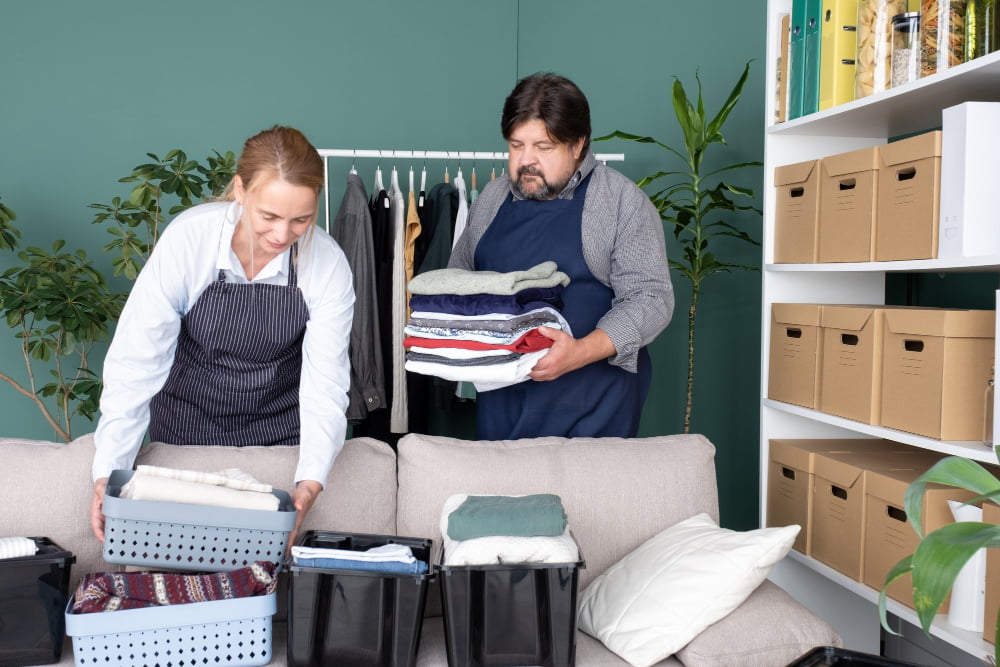
In certain cases, the step towards decluttering could seem overwhelming and a solo journey may not be feasible. Here, professionals trained to handle hoarding situations can provide invaluable assistance.
They not only assist in the physically demanding task of decluttering but also offer emotional support, providing a sense of empathy and understanding throughout the process.
A professional organizer can also help implement a customized organizing system in your space, making it easier to maintain its tidiness in the future.
Similarly, therapists specializing in hoarding can assist in overcoming the emotional challenges associated with discarding possessions and can equip individuals with strategies to prevent future clutter.
It’s essential to choose professionals who are experienced in handling hoarding situations to ensure a sensitive and respectful approach is maintained during the decluttering process.
Remember, reaching out for support is not a sign of weakness, but a strategic step in the journey towards a clutter-free life.
The Role of Family and Friends in the Decluttering Process
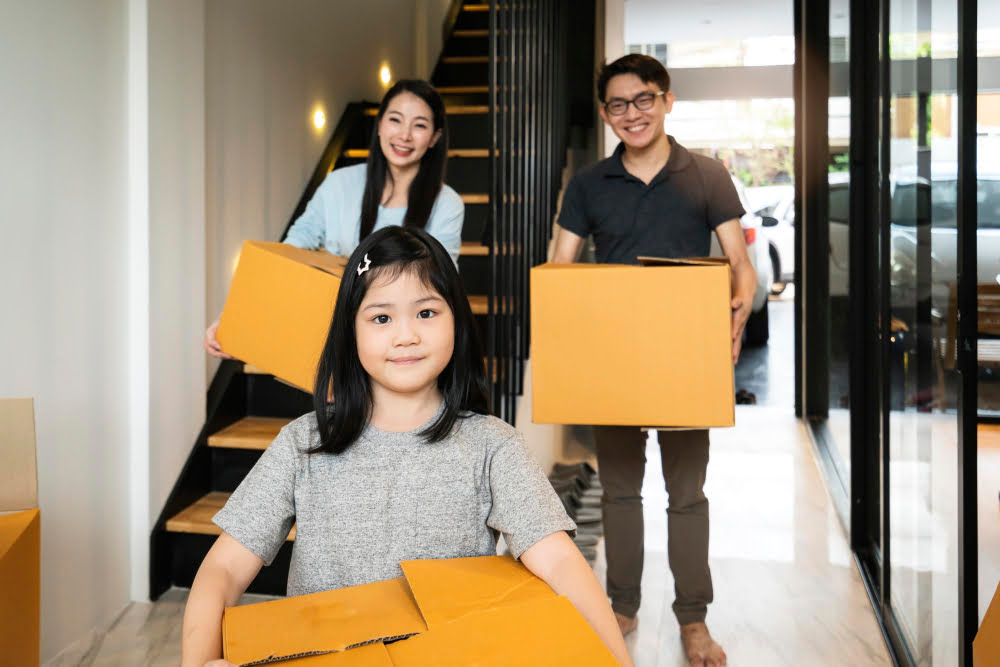
Support from loved ones serves as a crucial pillar during the decluttering process. They provide emotional backing, physical assistance, and more importantly, act as accountability partners.
Through their involvement, the overwhelming task of sorting through a mountain of clutter becomes manageable. It’s advisable for family and friends to approach this supportive role with patience, understanding, and sensitivity.
Hoarders often develop emotional attachments to their items, making the decluttering exercise a painful, emotional process. Therefore, it’s important for the support network to avoid rushing the process or forcing decisions on what should be discarded.
Moreover, family and friends can also aid in researching local options for re-homing, selling, recycling, or disposing of discarded items. Ensuring these objects find a new place or purpose can lessen the emotional strain imposed by parting with the items.
In conclusion, the supportive role of close relations not only aids in the successful completion of the decluttering process but also contributes to the prevention of a relapse into hoarding.
Staying Motivated During the Decluttering Process

Keeping motivation high is crucial to the sustainability of your decluttering journey. Start by setting realistic goals. Very often, small wins lay the foundation toward achieving bigger targets.
Cease the opportunity to celebrate each progress, no matter how small. It helps you remain focus on the task at hand and propels you to do more.
Visual reminders, such as before and after photos, can serve as powerful incentives. They provide tangible proof of how far you’ve come and what you can achieve when you persist.
Implement a reward system to pamper yourself for milestones reached. These rewards, which could range from a relaxing bath to a favorite movie night, help to reenergize you for the next decluttering phase.
Finally, consistency is key. Although the process may seem slow and tedious, remember that the end result is a soothing, clutter-free space. Carry this vision in your mind, it’s a pot of gold that sits at the end of your decluttering rainbow and a strong motivation to keep you going.
Maintaining a Hoard-Free Lifestyle

Developing good habits is vital in the fight against clutter. Regularly taking inventory of your possessions can help prevent accumulation of unnecessary items.
Create a system where, for every new item brought into your home, an old one is discarded, donated, or sold.
Ensure your space has sufficient storage to prevent items from piling up. Each object should have its designated place, so it’s easy to know where to return it when not in use.
Practice mindful shopping to avoid impulse buys that contribute to clutter. Ask yourself if the new item will have a specific function in your home and space to store it.
Once your home is decluttered, schedule routine checks for clutter hotspots. Regular purges, perhaps quarterly, should keep your space tidy.
Finally, celebrate the serene space you’ve created. Enjoy your clutter-free environment and let it positively transform your life and well-being. This achievement will provide motivation to maintain a hoard-free home.
How to Avoid Relapses Into Hoarding

Maintaining a clutter-free space goes hand in hand with addressing the underlying causes of hoarding. Psychotherapy, specifically cognitive-behavioral therapy (CBT), has been proven effective in treating hoarding behaviors.
Alongside professional help, establish a daily routine of tidying up. Spend at least 15 minutes each day organizing a specific area to ensure items don’t pile up.
Embrace minimalism by questioning the necessity and value of new acquisitions. Commit to the “one in, one out” rule: for every new item brought into the home, one item must leave.
Crucially, develop a strong, organized system for managing paperwork, clothes, and other common clutter items. Regularly check these systems and update them as needed.
Lastly, cultivate a supportive social network. Open communication about hoarding tendencies can offer motivation and accountability. Friends and relatives can regularly check-in or even help with routine decluttering, creating a beneficial social aspect to an often isolating challenge.
The Psychological Benefits of a Clutter-Free Space

Liberating your surroundings from excess mess does wonders not just for your physical space, but also for your mental well-being. It provides a sense of achievement, instills a feeling of freedom, and helps eliminate stress related to disarray.
A tidy home reduces distractions, making it easier to focus on tasks at hand, thereby improving productivity. It also directly correlates with enhanced cognitive functioning – a less chaotic environment supports clearer thought processes and decision-making abilities.
Moreover, a decluttered space contributes significantly to emotional health. It evokes feelings of peace and contentment, rather than anxiety and overwhelm that cluttered areas often induce. The act of decluttering serves as a form of self-care, showing respect for personal space and promoting improved self-esteem.
Finally, maintaining a neat and orderly space encourages healthier habits and routines that further support mental well-being. These positive adaptations can be instrumental in breaking the cycle of hoarding, paving the way to continued success in sustaining a clutter-free space.
FAQ
What is the 20 rule decluttering?
The 20/20 rule in decluttering is a guideline that suggests disposing of items if they can be replaced for less than $20 and within 20 minutes.
What is the first rule of decluttering?
The first rule of decluttering is to avoid having a ‘maybe pile,’ necessitating decisive action on whether to keep or discard each item.
What should you not say to a hoarder?
When communicating with a hoarder, it is crucial not to label their possessions as ‘junk’ or ‘rubbish’ and avoid pushing for a total cleanup, as this is likely to bring about resistance due to their emotional attachment to the items.
How do you declutter when you are overwhelmed?
When feeling overwhelmed, decluttering can be tackled in manageable parts by either focusing on one small area at a time, such as a single drawer or shelf, or setting aside a dedicated length of time for progress, like five minutes daily or a large time block for rapid progress.
What is the best way to motivate a hoarder to declutter?
To motivate a hoarder to declutter, emphasize the personal benefits of a clean space, including increased safety, improved mental well-being, and better living conditions.
How does the 4 box method aid in decluttering?
The 4 box method aids in decluttering by categorizing items into four boxes labelled ‘Trash’, ‘Give Away’, ‘Keep’, and ‘Relocate’, thus facilitating decision-making about an item’s necessity and appropriateness within the space.
How can a person declutter a room in one day?
To declutter a room in one day, one needs to categorize objects into ‘keep’, ‘donate’, ‘recycle’, or ‘discard’, then deeply clean and organize the ‘keep’ items systematically in designated storage spaces.
Related Stories
- 10 Declutter Memes to Inspire Your Cleaning Journey
- Decluttering Motivation: Inspiring Stories to Fuel Your Journey
- How to Help a Hoarder: Practical Steps and Support Strategies
- How to Get Rid of Sentimental Clutter: Effective Strategies for Simplifying
- Free Printable Decluttering Checklist: Organize Your Space Easily